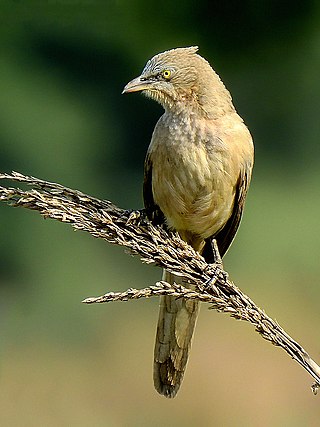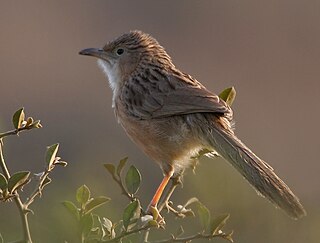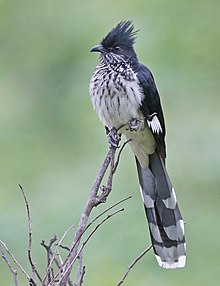
The orange-headed thrush is a bird in the thrush family.

The cuckoo, common cuckoo, European cuckoo or Eurasian cuckoo is a member of the cuckoo order of birds, Cuculiformes, which includes the roadrunners, the anis and the coucals.

The fan-tailed raven is a passerine bird of the crow family native to Eastern Africa and the Arabian Peninsula.

The red-necked falcon is a bird of prey in the falcon family with two disjunct populations, one in India and the other in Africa. This medium-sized falcon has bluish grey wings and upper body, a chestnut red cap with short chin straps passing through the eye. The primary feathers of the wing are black and a single black band at the tip of the tail are distinctive. The Indian subspecies Falco chicquera chicquera also known as the red-headed merlin or red-headed falcon is found mainly in the open plains of the India Subcontinent although it is thought to have occurred further west in southeastern Iran. The subspecies Falco chicquera ruficollis found in sub-Saharan Africa is sometimes treated as a full species, the rufous-necked falcon, on the basis of its well-separated geographic range and distinctive pattern. It appears very similar to the Indian form but has dark barring on the upperparts, a rufous breast band, and black moustachial and eye stripes. As in most falcons, the females are larger and falconers in India called the female turumti and the male as chatwa. They hunt in pairs mostly at dawn and dusk, capturing small birds, bats and squirrels.

The Jacobin cuckoo, also pied cuckoo or pied crested cuckoo, is a member of the cuckoo order of birds that is found in Africa and Asia. It is partially migratory and in India, it has been considered a harbinger of the monsoon rains due to the timing of its arrival. It has been associated with a bird in Indian mythology and poetry, known as the chātaka represented as a bird with a beak on its head that waits for rains to quench its thirst.

The jungle babbler is a member of the family Leiothrichidae found in the Indian subcontinent. Jungle babblers are gregarious birds that forage in small groups of six to ten birds, a habit that has given them the popular name of "Seven Sisters" in urban Northern India, and in Bengali, with cognates in other regional languages which also mean "seven brothers".

The yellow-billed babbler is a member of the family Leiothrichidae endemic to southern India and Sri Lanka. The yellow-billed babbler is a common resident breeding bird in Sri Lanka and southern India. Its habitat is scrub, cultivation and garden land. This species, like most babblers, is not migratory, and has short rounded wings and a weak flight and is usually seen calling and foraging in groups. It is often mistaken for the jungle babbler, whose range overlaps in parts of southern India, although it has a distinctive call and tends to be found in more vegetated habitats. Its name is also confused with Turdoides leucocephala, which is also known as white-headed babbler.

The Indian cuckoo or short-winged cuckoo is a member of the cuckoo order of birds, the Cuculiformes, that is found in the Indian subcontinent and Southeast Asia. It ranges from India, Bangladesh, Bhutan, Nepal and Sri Lanka east to Indonesia and north to China and Russia. It is a solitary and shy bird, found in forests and open woodland at up to 3,600 m (11,800 ft).

The common hawk-cuckoo, popularly known as the brainfever bird, is a medium-sized cuckoo resident in the Indian subcontinent. It bears a close resemblance to the shikra, even in its style of flying and landing on a perch. The resemblance to hawks gives this group the generic name of hawk-cuckoo; like many other cuckoos, these are brood parasites, laying their eggs in the nests of babblers. During their breeding season in summer males produce loud, repetitive three-note calls that are well-rendered as brain-fever, the second note being longer and higher pitched. These notes rise to a crescendo before ending abruptly and repeat after a few minutes; the calling may go on through the day, well after dusk and before dawn.

The large gray babbler is a member of the family Leiothrichidae found across India and far western Nepal. They are locally common in the scrub, open forest and gardenland. They are usually seen in small groups and are easily distinguished from other babblers in the region by their nasal call and the whitish outer feathers to their long tail. It is one of the largest babblers in the region.

The common babbler is a member of the family of Leiothrichidae. They are found in dry open scrub country mainly in India. Two populations are recognized as subspecies and the populations to the west of the Indus river system are now usually treated as a separate species, the Afghan babbler. The species is distinctly long-tailed, slim with an overall brown or greyish colour, streaked on the upper plumage and having a distinctive whitish throat.

Clamator is a genus of large brood-parasitic cuckoos with crests and graduated tails.

The Cape wagtail, also known as Wells's wagtail, is a small insectivorous bird which is widespread in southern Africa. It frequents water's edge, lawns and gardens. It is a mostly resident, territorial species, but has been known to undertake limited altitudinal migration or form flocks outside of the breeding season. Like other wagtails they are passerine birds of the family Motacillidae, which also includes the pipits and longclaws.

The plaintive cuckoo is a species of bird belonging to the genus Cacomantis in the cuckoo family Cuculidae. It is native to Asia, from India, Nepal and China to Indonesia.

The African cuckoo or African grey cuckoo is a species of cuckoo in the family Cuculidae. It is found in Sub-Saharan Africa where it migrates within the continent, generally arriving and breeding in any one locality during the rainy season. A fairly common bird, the International Union for Conservation of Nature has rated its conservation status as being of "least concern".

The pallid cuckoo is a species of cuckoo in the family Cuculidae. It is the only species placed in the genus Heteroscenes. It is found in Australia, with some migration to the islands of Timor and Papua New Guinea. It is between 28 and 33 cm in size, with distinctive markings such as a dark bill, a dark eye with a gold eye-ring and olive grey feet which differentiate it from other cuckoos. The pallid cuckoo is similar in appearance to the oriental cuckoo, with barred immature pallid cuckoos being often mistaken for oriental cuckoos.

The pavonine cuckoo is a Neotropical cuckoo with a long graduated tail and a short crest. It is one of three species of Neotropical cuckoo which are known to be brood parasites.

The Pacific long-tailed cuckoo, also known as the long-tailed cuckoo, long-tailed koel, sparrow hawk, home owl, screecher, screamer or koekoeā in Māori, is a species of the Cuculidae bird family. It is a migratory bird that spends spring and summer in New Zealand, its only breeding place, and spends winter in the Pacific islands. It is a brood parasite, laying its eggs in the nests of other bird species and leaving them to raise its chicks.

The cuckoo-finch, also known as the parasitic weaver or cuckoo weaver, is a small passerine bird now placed in the family Viduidae with the indigobirds and whydahs. It occurs in grassland in Africa south of the Sahara. The male is mainly yellow and green while the female is buff with dark streaks. They lay their eggs in the nests of other birds.

The brown babbler is a species of bird in the family Leiothrichidae. It is predominantly found in West Africa, but ranging from the Gambia to Kenya. The species is common across its range. The species is also known as the Sudan babbler.























